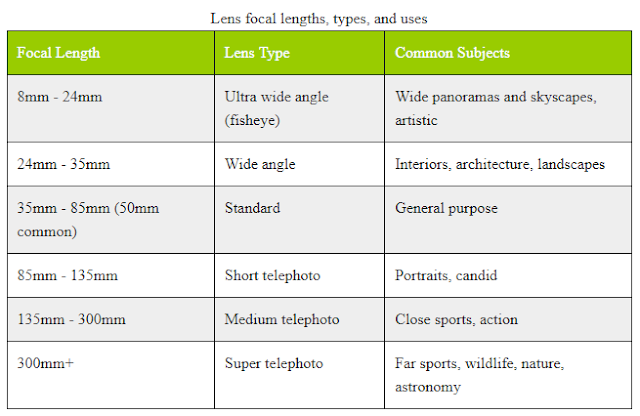The major things you need to consider when buying a lens fall into four categories:
-
The
optical quality of the lens: The better the lens, the better
it can
capture - resolve - fine details. In most cases,
the optical quality of digital camera lenses go hand in hand with the
price of the camera and the resolution of the sensor. At higher price
levels, camera lenses have better-quality optics, which are necessary
to keep
up with the detail capturing capabilities of higher megapixel image
sensors.
-
The
speed of the lens: A lens' speed is determined by
the maximum
amount of light the lens is capable of transmitting—the
largest f-stop
value. Some camera lenses can capture larger amounts of light than
others,
generally because they have a greater diameter that can transmit more
light. Think of a 1-inch-diameter pipe and a 2-inch-diameter pipe and
visualize how much more water (or light) the wider pipe can conduct.
Lens speed, in part, controls how low of a light level you can take pictures in and separates lenses into two categories - fast and slow. Fast camera lenses allow photographers to shoot at higher shutter speeds in low-light conditions. If you take many pictures in dim light, you will want a faster lens. For example, camera lenses with maximum f-stop values between 1.0 and 2.8 are considered fast
-
The
focusing range of the lens: The minimum focus distance of a
lens determines how close you can get to a subject. If too close, the
image will be blurry. Some camera lenses can focus closer than others.
The
ability to get up-close and personal with your subject can be very
important in some types of photography.
-
The
magnification range of the lens: The zoom range determines
how much or how little of a particular subject you can include in an
image from a particular shooting distance. You might be able to take
your basic image and double it in size (a 2:1 zoom ratio), triple it (a
3:1 zoom), or magnify it 12X or more (a 12:1 zoom). As you might
expect, the ability to zoom enhances your creative options
significantly. At the widest settings (wide-angle settings), you can
take in broad sweeps of landscape, whereas in the narrowest view
(telephoto), you can reach out and bring a distant object much closer.
Deciding What Lens to Use When
Using a longer focal length lens (telephoto), everything appears closer than it actually is.
With a shorter focal length lens (wide-angle), everything looks farther away.
A normal-focal-length (50mm) lens is not necessarily the one photographers normally use. Deciding what camera lenses to use comes down to the types of objects in your photographs and the amount of time you have to shoot them.
-
Shooting
in low lighting conditions: The maximum apertures of f/3.5 to
f/4.5 in the basic camera lenses are much too "slow" to be useful in
low light levels. When shooting in such conditions, you will be looking
to use zoom lenses with maximum aperture
of f/2.8 or selecting a fixed
focal length lens with an f/1.4 to f/2.0. You can invest in 28mm, 30mm,
35mm, 50mm, or 85mm f/1.4 lenses that can shoot under very dark
conditions.
-
Shooting
sharper images: If you are after sharper images, you can
often get better results with a special lens that was designed to
produce sharper images. You might look into buy a close-up lens that is
optimized for macro photography and produces especially sharp images at
distances of a few inches or so.
-
Shooting
wider angle scenes: Using a wide-angle lens lets you take in
a broader field of view, which can be useful when there is not enough
room to move farther away from your subject.
-
Shooting
farther away: A telephoto lens lets you bring distant objects
that much closer to your camera and makes it especially useful when you
cannot get close to your subject.
-
Shooting
closer: An interchangeable lens you buy may be able to focus
on subjects a lot closer to the lens, giving you valuable close-up or
macro capabilities.




No comments:
Post a Comment